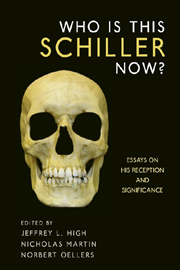Book contents
- Frontmatter
- Contents
- Foreword
- Acknowledgments
- List of Abbreviations
- Introduction: Why Is This Schiller [Still] in the United States?
- Part I Schiller, Drama, and Poetry
- Part II Schiller, Aesthetics, and Philosophy
- Part III Schiller, History, and Politics
- Part IV Schiller Reception — Reception and Schiller
- Part V Schiller Now
- 24 Maria Stuart Adaptations in the Twentieth and Twenty-First Centuries: From “Classical” Parodies to Contemporary Politics
- 25 Whose Schiller Is This? Das Fremde und das Eigene in US Auslandsgermanistik
- 26 Schiller's Political Ideas: Who Cares?
- 27 Where is This Schiller Now?
- Notes on the Contributors
- Index
25 - Whose Schiller Is This? Das Fremde und das Eigene in US Auslandsgermanistik
from Part V - Schiller Now
Published online by Cambridge University Press: 05 February 2013
- Frontmatter
- Contents
- Foreword
- Acknowledgments
- List of Abbreviations
- Introduction: Why Is This Schiller [Still] in the United States?
- Part I Schiller, Drama, and Poetry
- Part II Schiller, Aesthetics, and Philosophy
- Part III Schiller, History, and Politics
- Part IV Schiller Reception — Reception and Schiller
- Part V Schiller Now
- 24 Maria Stuart Adaptations in the Twentieth and Twenty-First Centuries: From “Classical” Parodies to Contemporary Politics
- 25 Whose Schiller Is This? Das Fremde und das Eigene in US Auslandsgermanistik
- 26 Schiller's Political Ideas: Who Cares?
- 27 Where is This Schiller Now?
- Notes on the Contributors
- Index
Summary
Whereas literary and cultural studies have expanded well beyond the limits of traditional methods and approaches, this essay asserts that there are still unofficial restrictions to what one can do with Schiller and that philologically oriented work is generally favored over more speculative pieces. The question of who owns Schiller leads to an investigation of what it is that we allow into our journals, on to our bookshelves, and into our classrooms. Does Schiller belong to those who tend and protect the cultural legacy or to those who try to claim him for the present?
“DOCH mÖCHTE ICH DIESE Amerikanisierung und Verballhornung Schillers meinen Studenten nicht zumuten.” Thus spake an eminent scholar at the conclusion of a review of Stephanie Hammer's monograph Schiller's Wound. Hammer's work is psychoanalytically informed and prone, like the unconscious, to placing its objects in unaccustomed contexts — especially pop-cultural ones. The descent into popular culture constitutes part of the charge of Americanizing in this case, but only part. Additionally, the reviewer was disturbed by Hammer's efforts to embed Schiller in the web of contemporary concerns (Aktualisierung) and by the perceived brevity of her engagement with the philological background. I will return to this presently, but I wanted to quote this statement at the outset to raise certain questions along the lines of What are the characteristics (or national characteristics) of legitimate scholarship, its compulsory figures?
- Type
- Chapter
- Information
- Who Is This Schiller Now?Essays on his Reception and Significance, pp. 425 - 437Publisher: Boydell & BrewerPrint publication year: 2011

